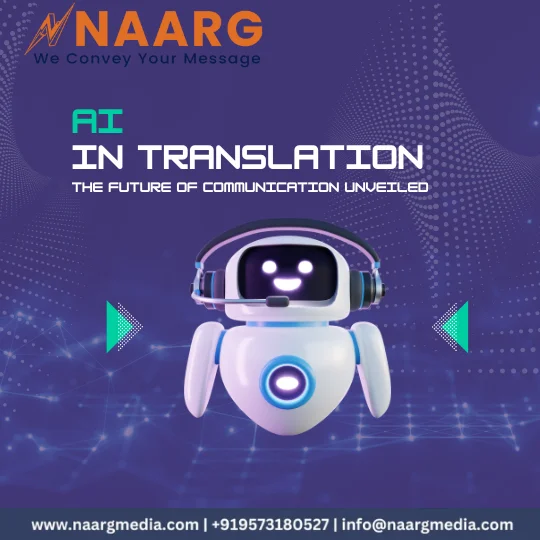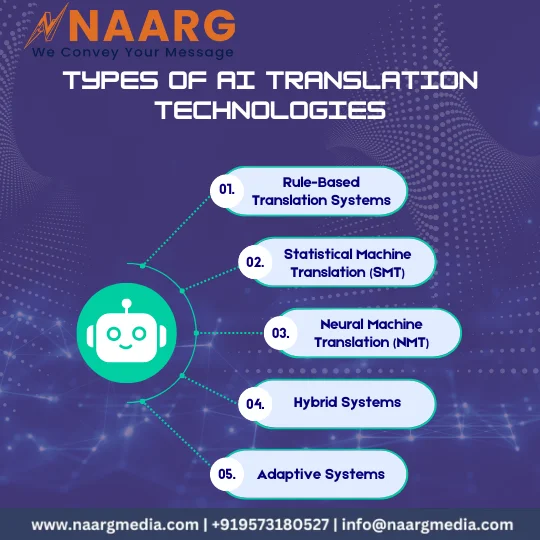In today’s fast-paced world, the need for accurate and efficient communication across languages is critical. The AI translation market is booming, expected to reach USD 13.5 billion by 2033!
This highlights the growing demand for AI’s transformative power in bridging language barriers. Enter AI in the translation industry—a revolutionary advancement that promises to transform how we bridge language barriers.
From enhanced machine learning to neural networks, AI is setting new standards in translation. But what makes AI such a game-changer? Let’s delve into the fascinating world of AI-powered translation.

Key Components of AI in Translation
Understanding the key components that power AI in the translation industry helps us appreciate its transformative potential. Here are some critical elements:
1. Natural Language Processing (NLP)
NLP is the cornerstone of AI translation. It allows machines to comprehend and process human language, making it possible to interpret meaning, context, and sentiment.
NLP algorithms break down and analyze text, enabling AI systems to understand linguistic nuances and provide more accurate translations.
2. Machine Learning
At the heart of AI translation lies machine learning. These algorithms are trained on vast amounts of multilingual data, learning from each interaction to improve their accuracy over time.
Machine learning models adapt and evolve, continually refining their understanding of language patterns, idiomatic expressions, and context-specific nuances.
3. Neural Networks
These advanced computational models are designed to simulate the human brain’s functioning. Neural networks enhance the quality of translations by recognizing complex patterns in data and making connections that traditional algorithms might miss. This capability allows for more natural and fluid translations that closely mimic human speech and writing.
4. Automated Translation
One of the most significant benefits of AI in translation is its ability to perform translations without human intervention. Automated translation systems deliver speed and efficiency, processing large volumes of text in real-time.
This capability is precious for businesses and organizations that need to translate content quickly and accurately.
5. Localization
Localization goes beyond mere translation. It involves tailoring translations to fit cultural and regional nuances, ensuring that the content resonates with the target audience.
Localization considers factors like local customs, idioms, and cultural references, making the translated content more relatable and effective. This aspect of AI translation is crucial for businesses aiming to connect with diverse global audiences.
Types of AI Translation Technologies
AI in the translation industry employs a variety of technologies, each with unique strengths:

1. Rule-Based Translation Systems
These systems rely on predefined linguistic rules to perform translations. They use extensive dictionaries and grammar rules to translate text from one language to another.
While they can be highly accurate for specific language pairs and domains, their rigidity often limits their ability to handle idiomatic expressions and context-dependent nuances.
2. Statistical Machine Translation (SMT)
SMT relies on statistical models derived from analyzing large text corpora. By examining patterns and frequencies of word alignments between languages, SMT systems can generate translations based on probability.
Although they offer greater flexibility compared to rule-based systems, their performance heavily depends on the quality and quantity of the training data.
3. Neural Machine Translation (NMT)
NMT utilizes deep learning techniques to produce more natural and accurate translations. These systems use neural networks to process entire sentences as single units, capturing contextual meanings and subtleties.
NMT has significantly improved translation quality, making translations more fluent and closer to human-level performance.
4. Hybrid Systems
Combining the strengths of rule-based and statistical methods, hybrid systems offer a balanced approach to translation.
They leverage the accuracy of rule-based systems and the adaptability of statistical models, resulting in more robust and reliable translations.
5. Adaptive Systems
These systems learn from user corrections and feedback to continually improve translation quality. By integrating machine learning with user inputs, adaptive systems refine their algorithms over time, ensuring more accurate and contextually relevant translations with each iteration.
These diverse AI translation technologies collectively enhance the capabilities of the translation industry, offering solutions that are both efficient and accurate across different languages and contexts.
Major AI Translation Tools and Platforms
Several tools and platforms have emerged as leaders in the AI translation space. Here are some notable ones:
1. Google Translate
As one of the most widely used translation tools, Google Translate employs neural networks to enhance translation accuracy. Its ability to support over 100 languages and its continuous learning from user input make it a powerful tool for both casual and professional use.
2. Microsoft Translator
Known for its real-time translation capabilities, Microsoft Translator seamlessly integrates with other Microsoft products, such as Office and Skype. This integration allows for smooth communication across languages in various professional and personal contexts.
3. DeepL Translator
DeepL is renowned for its high-quality translations and ability to handle complex sentences with precision. It uses advanced neural network technology to deliver translations that are often more accurate and nuanced than those of its competitors, making it a favorite among professionals who require detailed and accurate translations.
4. Amazon Translate
Amazon Translate offers scalable and reliable translation services, making it ideal for businesses. Its API allows for easy integration with other Amazon Web Services (AWS), providing businesses with robust and efficient translation solutions for websites, applications, and content.
5. SYSTRAN
With a long history in the translation industry, SYSTRAN provides a comprehensive suite of translation tools, including computer-assisted translation (CAT) features. SYSTRAN’s solutions are tailored for various industries, offering specialized translation services that ensure accuracy and relevance.
These platforms demonstrate the diverse applications of AI in translation, catering to different needs from casual use to professional and business environments. Each tool leverages advanced AI technologies to deliver fast, accurate, and contextually appropriate translations, showcasing the transformative potential of AI in the translation industry.
How Does AI Enhance Translation Quality?
AI significantly enhances translation quality through a series of well-defined steps:
1. Data Collection
The foundation of any AI translation system is a vast repository of multilingual data. This data is essential for training AI models, providing a diverse range of examples that help the AI learn various language patterns, idiomatic expressions, and contextual usages.
2. Model Training
Using machine learning, these collected data sets are used to develop and refine AI models. The models are trained to recognize and predict language structures and patterns. This process involves feeding the AI numerous examples, enabling it to understand and mimic the nuances of human language.
3. Contextual Understanding
Natural language processing (NLP) plays a crucial role in this step. NLP allows the AI to grasp the context of the text it is translating, ensuring that the meaning is preserved across languages. This involves understanding not just individual words but also their relationship within sentences and larger text structures.
4. Error Correction
AI systems continuously learn from their mistakes. By analyzing errors and incorporating user feedback, the AI refines its algorithms to produce more accurate translations. This iterative process ensures that the AI improves over time, becoming more adept at handling complex and nuanced language tasks.
5. Localization
Beyond mere translation, AI adapts content to fit cultural and regional specifics through localization. This ensures that the translated text is not only accurate but also culturally relevant and appropriate. Localization considers local customs, idioms, and other cultural elements, making the content more relatable and effective for the target audience.
By following these steps, AI systems enhance the accuracy, efficiency, and relevance of translations, bridging language barriers more effectively than ever before.
AI and Human Translators: A Collaborative Future
While AI brings unprecedented efficiency and accuracy to translations, human translators remain indispensable. The future of translation lies in a collaborative approach, where AI handles repetitive tasks and human translators focus on nuanced and creative aspects.
AI excels in processing large volumes of text quickly and consistently. It uses translation memory to remember previously translated phrases, ensuring consistency across documents.
Speech recognition technology transcribes spoken language into text, which AI can then translate, making real-time communication smoother. However, human translators are crucial for ensuring the translated content’s cultural relevance and emotional resonance.
They bring an understanding of context, cultural nuances, and idiomatic expressions that AI still struggles to grasp fully. For instance, translating marketing materials or literary works requires creativity and an appreciation of subtleties that only a human can provide.
This synergy between AI and human translators enhances overall translation quality. AI manages the bulk of the work, providing fast and accurate base translations. Human translators then refine these translations, adding the necessary cultural and contextual layers.
This collaborative model not only improves efficiency but also ensures high-quality, sophisticated, and culturally sensitive translations. AI tools like translation memory and speech recognition assist human translators, making their work faster and more accurate.
By leveraging the strengths of both AI and human translators, we can achieve translations that are not only precise but also deeply resonant and impactful, bridging language barriers more effectively than ever before.
Conclusion
The future of AI in the translation industry is bright, promising significant advancements in how we communicate across languages. By leveraging machine learning, neural networks, and NLP, along with advanced language models, AI is set to revolutionize translation.
As we look ahead, the collaboration between AI and human translators will only grow stronger, ensuring high-quality and culturally relevant translations. Embrace the future of translation with AI, and witness a new era of seamless communication unfold.
Tired of language barriers holding you back? As one of the leading artificial intelligence data translation services providers with more than a decade of experience, we have achieved a high level of recognition.
Ready to see the difference? Contact us today!
